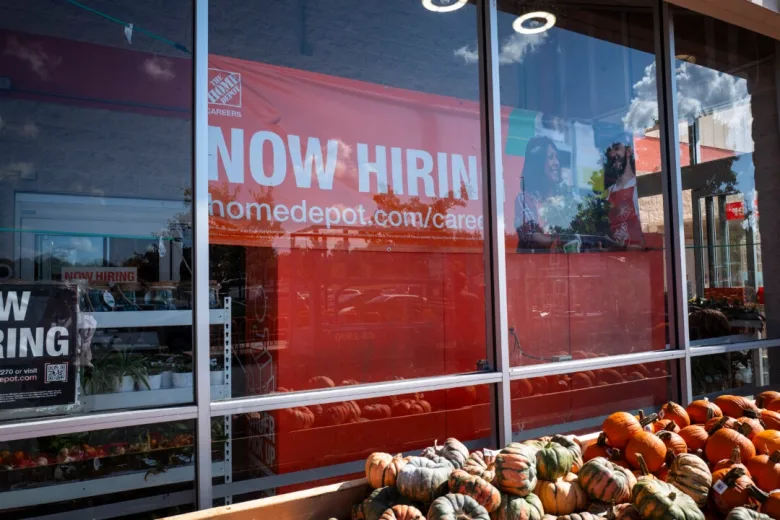By Andrew Moran
The number of job openings remained little changed in August, as the U.S. economy’s “low fire, low hire” trend continued.
Job vacancies edged up last month by 19,000, to 7.227 million, according to the Bureau of Labor Statistics’s Job Openings and Labor Turnover Survey (JOLTS) report, released on Sept. 30.
The previous month’s reading was revised slightly higher, to 7.208 million from 7.181 million.
Economists had penciled in a reading of 7.2 million.
A significant decline in job openings was observed in construction (negative 115,000) and in the federal government (negative 61,000).
Bureau data show that the number of job quits—a measure economists monitor to gauge workers’ confidence in the labor market—fell by 75,000, to a 11-month low of 3.091 million from a downwardly adjusted 3.166 million.
The number of quits was primarily concentrated in accommodation and food services (negative 140,000) and arts, entertainment, and recreation (negative 22,000). It grew in construction by 56,000.
The quits rate, which measures voluntary job leaves as a share of total employment, dipped to 1.9 percent from 2 percent.
Continuing the trend of the past year, the United States experienced little hiring and few layoffs last month. The number of new hires and terminations was little changed at 5.1 million and 1.7 million, respectively.
The JOLTS report kicks off a week of highly anticipated employment numbers, culminating in the main event on Oct. 3: the September jobs report.
Early estimates suggest the U.S. economy added 50,000 new jobs, with the unemployment rate holding steady at 4.3 percent.
“Expectations are for the rate to remain unchanged at 4.3 percent,” Jay Woods, chief global strategist at Freedom Capital Markets, said in a note emailed to The Epoch Times.
“Anything higher than that will not only justify the recent 25 basis-point cut, but fuel calls for more impactful cuts over the final two FOMC [Federal Open Market Committee] meetings of 2025. So bad news here may be great news for those lobbying for two more cuts this year.”
The Fed lowered interest rates by a quarter point for the first time this year, and officials presented a more conservative outlook for the home stretch of 2025 and throughout 2026 and 2027.
Slowing Down
During his post-meeting press conference earlier this month, Federal Reserve Chair Jerome Powell noted that the U.S. labor market is in a “curious balance” as the supply of and demand for labor are slowing simultaneously.
The JOLTS report has illustrated the steady slowdown in the number of job vacancies since reaching a peak of 12.1 million in March 2022.
However, other figures also indicate a gradual decline in labor demand over the past year.
Job postings on Indeed in the United States have fallen since December. While there was a summertime uptick, they have registered a sharp downturn since late August.
Allison Shrivastava, an economist at Indeed Hiring Lab, says that while job postings overall are 4 percent higher than their pre-pandemic baseline, they remain 7 percent lower than they were a year ago.
“Despite the recent slowdown in hiring demand, layoffs remain low, and unemployment has stayed steady. Fewer workers are quitting—a signal of caution in the overall market—and the pace of job creation has slowed considerably,” she said in the report.
One notable demographic that is contending in a challenging labor market, says Shrivastava, are new entrants who are navigating junior or entry-level roles, which “are currently shrinking the fastest.”
The unemployment rate for male U.S. graduates aged 22–27 has steadily risen since March 2024, exceeding 6 percent in July. The overall youth unemployment rate—individuals aged 16–24—reached a four-year high of 10.5 percent in August.
Monetary policymakers have begun to notice this trend, and some economists suggest that artificial intelligence (AI) is likely playing a role.
While speaking in Rhode Island at an event hosted by the Greater Providence Chamber of Commerce last week, Powell stated that it has “gotten tough for people entering the labor force to be hired” in today’s “low fire, low hire” environment.
However, at the same time, if young workers come out of college or university with technical skills, they will do fine.
“If you don’t have those skills, though, you’re increasingly left with less attractive employment options,” Powell said.
He also criticized the higher education landscape, noting that “U.S. educational attainment kind of plateaued.”
Even with strong technical skills, job growth among young people in several white-collar sectors has been anemic, particularly for graduates specializing in computer engineering design and architecture, according to economists at JPMorgan Chase.
While AI has yet to have a material impact at the aggregate level, Murat Tasci, senior U.S. economist at JPMorgan Chase, says the technology could significantly affect the labor market in the next downturn.
“We think that during the next recession, the speed and breadth of the adoption of AI tools and applications in the workplace might induce a large-scale displacement for occupations that consist of primarily non-routine cognitive tasks,” Tasci said in a research note last month.
For now, the U.S. economy is showing few signs of a recession.
The Federal Reserve Bank of Atlanta’s GDPNow Model estimates 3.9 percent growth in the third quarter, mirroring the expansion seen in the previous quarter.






